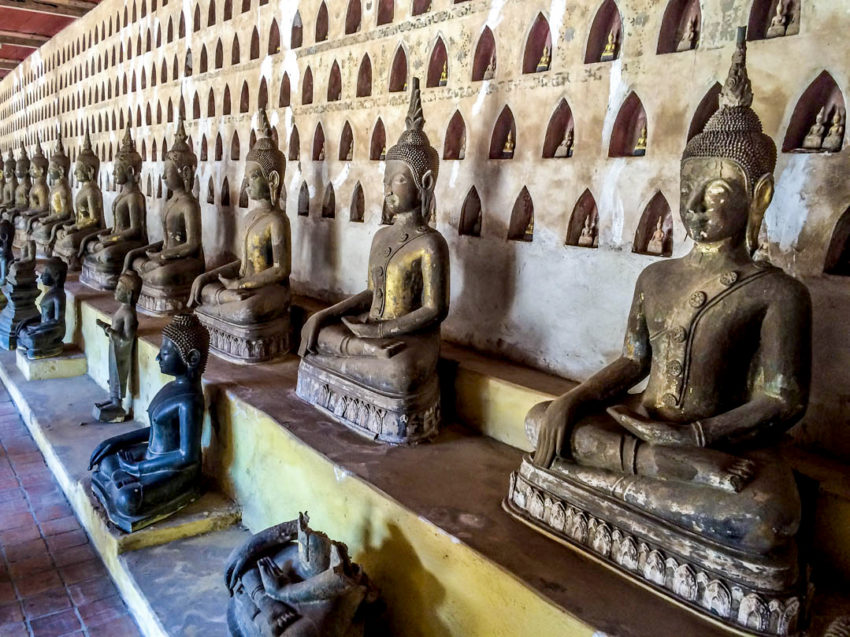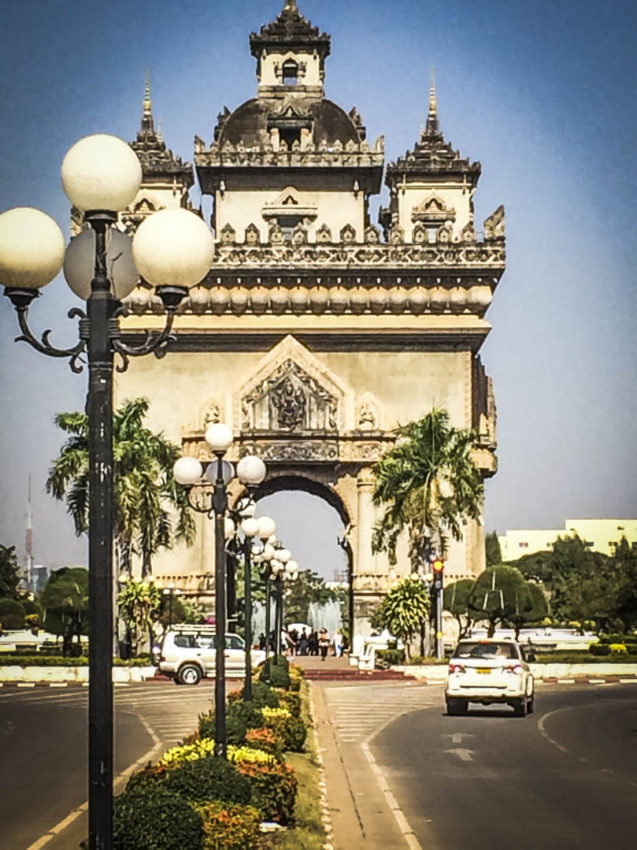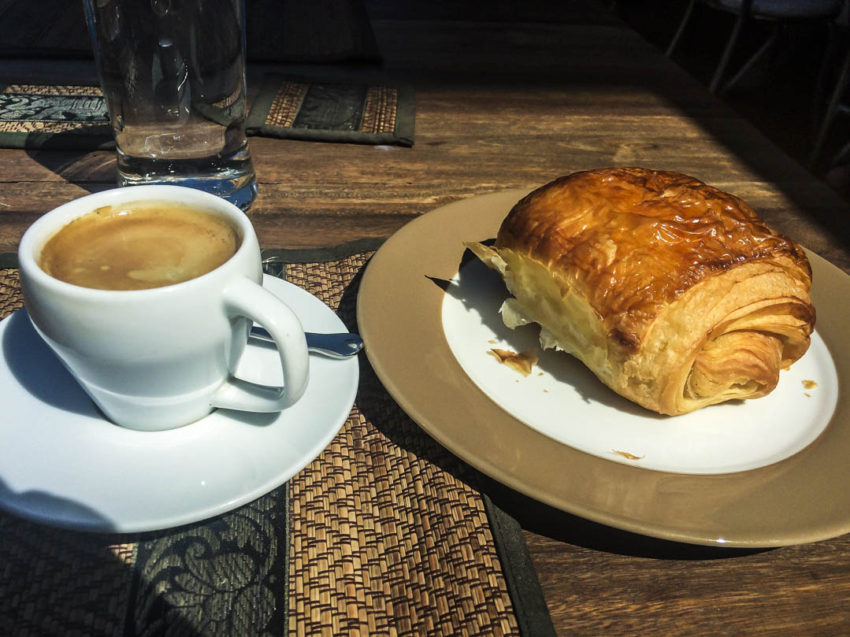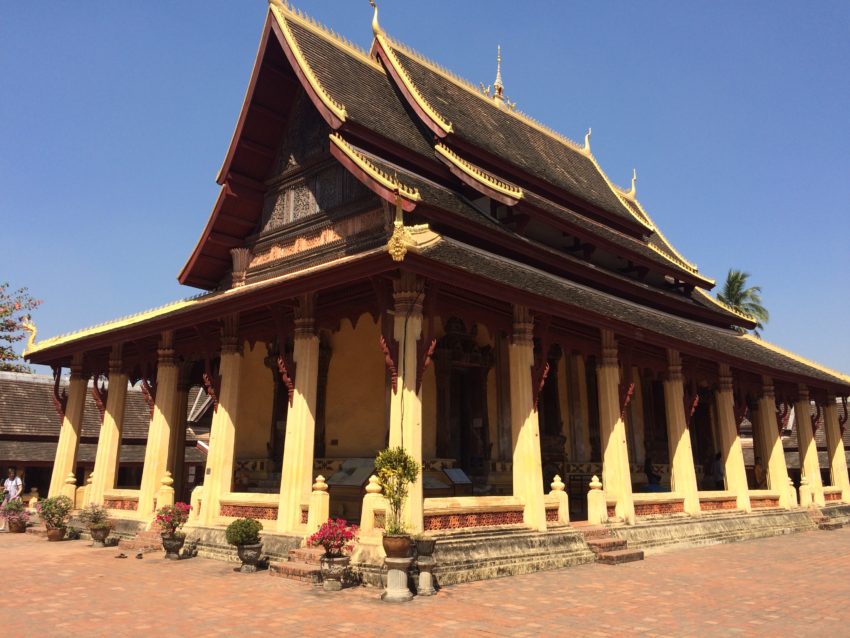Laos: My 100th country is slowly emerging from its poverty-stricken communist cocoon

VIENTIANE, Laos — What do you call someone who’s been to 100 countries? Am I now a centenarian? A countriarian? It makes me sound so old. I guess I am. It’s 100 countries in 60 years. I need to include the caveat “(and territories).” Purists wouldn’t include Puerto Rico and Guam. Some wouldn’t include Scotland and Wales. The World Almanac recognizes Scotland and Wales. That’s good enough for me. Puerto Rico and Guam have their own governments and teams in the Olympics. That’s good enough for me, too.
Whatever, I’ve come a long way from graduating from college owning more cars in my life (one) than passports. From my first step across the British Columbia border after the Seattle World’s Fair in 1962 to landing in Laos on Feb. 4, 2017, I have hit about every corner of the globe. Considering I didn’t go to another foreign country from 1962-78, that is some serious globetrotting. I climbed Kilimanjaro and one of the Great Pyramids. I scuba dived with sharks in French Polynesia. I rafted with crocodiles in Costa Rica. I ate Chateaubriand in Chateaubriand and drank Chianti in Chianti.

Based on the somewhat stodgy school of thought that you haven’t traveled unless you’ve suffered, well, I guess I’ve traveled. I caught typhoid in Thailand, got stuck in an underwater cave in Australia, got in a fistfight in Haiti, got chased out of a hotel room in Indonesia by giant wharf rats, had a machete pulled on me in Morocco, I thought I got kidnapped in Hungary and once stayed in a hotel in Egypt so filthy the shower and toilet shared the same drain. And once I even — and I shudder to even write this next sentence — woke up in Detroit!
In the realm of world travelers, 100 countries isn’t that many. The United Nations lists 195 member states. However, China blocks Taiwan from being a member. I do not. I have not been everywhere. I’ve missed all of southern and West Africa, the Persian Gulf, Central Asia and Antarctica. The oceans are dotted with lots of island nations I’ll never visit. I see no sense visiting an island with no beach unless you want to go to Kiribati and watch the locals drown stray kittens. (They really do. They say cats are bad luck.) I’m not into numbers. I only know it’s 100 because about 10 years ago I tired of people asking me. I finally counted. I didn’t even go to a new country in 2016. I revisited Hungary, Czech Republic and Belgium instead.
This year, No. 100 is attracting the same response from everyone.
“Why Laos?”
I always like that response. It means people know nothing about it. It’s the capital of one of the few communist countries left in the world. It has emerged from a past so provincial its economy as recently as the early ’90s was dependent almost totally on foreign aid.The government, following China’s lead, opened its arms to tourism and limited free enterprise in the 1990s under a reform called the New Economic Mechanism. The number of tourists jumped from 14,400 in 1990 to 4.68 million in 2015. According to Laos government records, revenue from tourism went from $2.25 million in 1991 to $406 million in 2011.
Yes, even communists need to eat.

From what I saw over four days, Vientiane, a city of 255,000, still has one rubber sandal stuck in its colonial past — which makes it one of the most charming capitals I’ve ever visited. It stretches languidly along the Mekong River separating Laos from Thailand. The narrow, quiet streets are void of many streetlights, let alone traffic jams. Street stalls share sidewalk space with family run noodle shops. The riverside is lined with locals selling fresh grilled fish and meats on a stick. You can eat fresh barbecued chicken for $1 then go upstairs to one of the many bars across the street and drink an ice-cold Beerlao while looking out over the Mekong.
From the moment my AsiaAir flight landed from Bangkok, I knew I’d like Vientiane. Its airport isn’t much bigger than some islands’ airfields in the Caribbean. Its immigration center is the size of a cafe. Standing in the long line waiting for my visa, I met a Canadian woman named Phillipa doing what I’d hear a lot of in Laos: She’s working in China and vacationing in Laos during the Chinese New Year which started Jan. 28. She’s been working in Shanghai for three years and still has that youthful exuberance of someone still excited about eating new foods and learning new languages. We met an Aussie who’s here for a six-month water maintenance project and a dour German woman who never paid me back for the cab we shared to our hotels. For nearly 20 years, Laos has become a haven for backpackers. Cheap beer. Sun. Good food. Laos has done something right.

We’re all on Sihome Road where the communist government put many backpacker hostels and hotels. It’s far from a gulag. My Vientiane Garden Hotel is set behind the girls’ Garden Hostel and an absolute palace for a budget traveler. I’m writing this near a pretty, little pool under the shade of huge trees and ferns. The hotel’s white concrete walls are set off by nice dark wood staircases and doors. A rusted barbell and two yellow buckets of empty Beerlao bottles in front of me are the only indication that this is still a developing country.
Actually, this is communism. During the Vietnam War, Laos had a neutral coalition government, whose Royal Lao Army the U.S. supplied with arms and money, while North Vietnam plied the communist Pathet Lao rebels. When the North won, Laos became the Lao People’s Democratic Republic, ending 650 years of monarchy. (Why do communist countries like German Democratic Republic and the Democratic People’s Republic of Korea call themselves democratic when there’s not a hint of democracy?).
When the communists took over in 1975, they curtailed the private sector, forced the collectivization of agriculture and curbed religion. About 10 percent of the country fled. Those who stayed circled the drain of what became an Asian backwater. In 1991 the World Bank listed Laos among the 10 poorest countries in the world. Then it hit rock bottom during the global economic crisis of the late ‘90s. What does it tell you about a country’s economy when it must get bailed out by Vietnam?

Laos also remained extraordinarily dangerous, not by gangs but bombs. During the Vietnam War, the U.S. conducted a “secret war” trying to keep Laos from becoming a communist domino. According to Legacies of War, a website dedicated to the memory of the Vietnam War, the U.S. dropped 2 million tons of bombs on Laos over 580,000 missions from 1964-73, many landing in the Plain of Jars in Northern Laos. Today, many of those bombs still rest in the countryside, hidden by overgrowth. Laos does nothing to hide the fact, even on maps. Anyone want to vacation in Bomb Village? Yes, that’s the name of a town near the Plain of Jars. Every year more than 60 Lao die from leftover bombs.
However, opening up the economic purse strings gave Laos a major financial injection. Here in the capital, they refurbished the waterfront and built new hotels and roads, mostly financed by China. Today Laos has one of the fastest growing economies in East Asia. From 2006-16, according to the World Bank, its poverty level dropped from 33.5 percent to 23.2 percent. More than half a million people were lifted out of poverty. Among the world’s poorest countries today, it’s not even in the top 25.
Vientiane now has the same relaxed vibe as during its days as a French colony from 1893 to 1953. I first noticed France’s lingering influence when I walked to dinner. On a dusty sidewalk, I walked past a tattered flag of the old USSR waving over a conference hall. In front of the hall stood a big clear glass case filled with gorgeous French pastries, some sprinkled with chocolate. And bread. Laos is crawling with bread, something I never had in Bangkok.
So the French left recipes, the Americans left bombs. Viva la France!
This goes back to answering the question, “Why Laos?” A big reason is food. While debating between Myanmar and Laos, Myanmar (formerly Burma) seemed like 90 percent pagodas and 10 percent human rights violations. I read virtually nothing about food. It makes sense. Who ever says, “Let’s go out for Burmese”? Laotian cuisine is heavily French influenced and I could tell by my first meal.
I took a local’s advice and went to Lao Kitchen. Walking past I saw it was clean and open air — and filled with tourists. The only Lao was a woman with a white guy. Maybe she was rented. Maybe they met on the Internet. I sat down next to three painfully young American girls scooping up their last bits of rice and nearly orgasming how great it was.

Whenever I enter a country for the first time, I try their national dish. In Laos it’s called Laab, or Lahp as Lonely Planet calls it. It’s either duck, chicken or beef mixed with fish sauce, shallots, mint leaves, lime juice, roasted ground rice and lots of chilies. It was one of the best national dishes I’ve had anywhere in Asia. It’s light, spicy and crunchy. The chilies didn’t overwhelm the lovely duck and the rice made for a nice crunchy substance. It was all of 40,000 kip ($5). My first Beerlao left me underwhelmed. It had the same industrialized taste as Singha or Budweiser. At 5 percent it didn’t give much of a wallop. But it was ice cold which means I can use it as a substitute for water the next three weeks.
I then found myself fed and lonely. I needed to talk. Two blocks away I found IBeam. IBeam is the perfect traveler’s bar. Arriving at about 9:30 p.m., I was one of only three Westerners. The rest were a bevy of gorgeous Lao women all dressed in skirts and heels. Not a single one winked at me or licked her lips. I didn’t have to learn the Lao term for “I have a girlfriend.” The bartender served me a Beerlao in a tall, elegant glass you’d find in Belgium and I settled back to watch a quartet called Black Magic play a nice collection of Western and Lao hits. While they played “Lady in Red,” “Desperado” and “Move Like Jagger,” I talked to a short, fit, bald American. He’s lived in Laos 16 years, right about the time of the economic explosion. I asked if he was happy.
“Not really,” he said. “I’m bored.”
He made Vientiane sound like a really small town, where places like the IBeam are the refuge after a long day battling communist bureaucracy. I asked him what he did for fun.
“This,” he said, raising his beer.
He works in ecotourism which has cleaned up its act over the last six or seven years. However, there’s a problem in going forward.
“They lack creativity here,” he said. “They never come up with anything new.”
He said the biggest problem facing Laos is lots of dam projects are threatening the livelihood of the rural fishermen who need the Mekong River, the 12th longest in the world, to make a living. Bridges are destroying the environment.
I left four beers and 80,000 kip later. That’s about $10. I wandered home, stopping briefly at an outdoor bar, one of the few allowed open past the 11:30 cutoff mark. Filled with expats and tourists, I nursed one last Beerlao and heard a Brit and French woman’s tale of their Danish friend thrown in a Chinese prison for two years for a murder he never committed. He’s still awaiting trial.
Communism isn’t dead yet, folks.
Touring Vientiane doesn’t take long which is why many travelers don’t stick around. Too bad. The relaxed atmosphere makes it feel like a giant fishing village. Vientiane is the only capital I’ve been to where you can count the street lights on two hands. Vientiane has a history going back 1,000 years with remnants still around through a 650-year-old kingdom, American imperialism and now full-fledged communism. But in pace, size and manageability, compared to Bangkok, Vientiane is color by numbers compared to Rubik’s Cube. I about walked the whole town in one afternoon, at least the central part.

I started the day at Le Banneton, a cafe right out of a back alley of Paris, no question built to remind the Lao that parts of the French yoke weren’t bad. I had a French chocolate pastry not much different than my fagottino back home in Rome and an espresso twice the size and just as tasty as mine. Lots of backpackers sat around reading Lonely Planet. Some expats sat inside from the growing heat working on their laptops. I couldn’t start the day any better.
Vientiane is lousy with pagodas. Unfortunately, none remain from its time in the sun: the 16th century when King Setthathirat moved the capital of the Lan Xang kingdom, Laos’ first monarchy dating to the 13th century, from Luang Prabang to Vientiane. Vientiane became a Buddhist mecca of sorts, attracting scholars from all over Southeast Asia.
But the Vietnamese, Burmese and Siamese took turns transforming the pagodas into so much kindling. The Lan Xang kingdom eventually crumbled and so did Vientiane’s period to shine. It became part of Siam’s empire in the late 18th century and Chao Anou, a Lao educated in Thailand, took over. He did a remake of the pagodas which is what dominate central Vientiane today.
It’s where I started my walk.

Wat Si Saket, built between 1818-1824, is a large block covering a bevy of temples. A long row of reclining gold Buddhas and black Buddhas are lined up on the side of the complex like sleeping sentries. The main temple has a sign that says, in English, that it’s due for a makeover — in 2014.
I guess Soviet-level efficiency hasn’t reached Laos.

Across the street stood the gargantuan Presidential Palace, as French as brie on a baguette. It’s what is called beaux arts and has three beautiful archways over an entrance. In a nod to the surroundings, the three steeples in the back give it a very Laotian taste.
I then strolled up Lan Xang Road, Vientiane’s main boulevard that is as wide as the Champs-Elysees. Here is where you feel the most French presence outside a bakery. At the end of Lan Xang stands the Patuxal. It’s similar to the Arc de Triomphe with a giant archway in the middle of a roundabout but the top deck is ringed with Oriental artwork and little pagoda domes. The American military gave it to the Lao government in 1969 to build a new airport. The Lao took the concrete and, instead, built a memorial to all the Lao who died in pre-revolutionary wars.
Thanks, Yanks.

The view isn’t bad. It’s just that there isn’t much to see. Vientiane is as flat as a rice paddy. I don’t think there’s a building more than five stories. It reminds me of Bangkok in the late ‘70s before foreign investment built a skyline and the new affluent Thai bought enough cars to ruin the air forever.
But some commercialization has ruined parts of Vientiane. Just past Talat Kua Din, a classic Asian fresh food market, stands Talat Sao. Apparently, for a generation, Talat Sao was Vientiane’s largest market and the place to go for famed Lao textiles. Now it’s just Vientiane’s largest market. A renovation turned 80 percent of it into a glittering mall. In the remaining 20 percent is stall after stall selling jewelry so gold it almost looked orange. In fact it’s about as valuable as fruit. An Indian shopkeeper told me it’s copper made in India. The famed textiles have been reduced to brightly colored wrap-around skirts with a sash, great if you’re going to an affair at an embassy here or filling some weird man’s fantasy but not appropriate anywhere in the Western world.
The walking took its toll. I tried looking for some place called Spirit House an allegedly classy cocktail bar perfect for sipping an overpriced cocktail as the sun sets on the Mekong. Instead, my thirst got me intercepted across the street at Chokdee. Chokdee means “Cheers” in Lao and the sign said, “Belgian Beer Bar.” The place was expensive. Imported beers were 35,000 ($4, about four times the price of your average Beerlao) but the lahb chicken with sticky rice was fantastic.
I kept a conversation with a retired Dutch guy named Andre. With the tired manner and frazzled hair of a world-weary old Asia hand, Andre spun a tale about his son who has lived in Laos for 18 years and runs textile factories. Andre told me you can get fined $2,000 if caught with a prostitute here. As in Thailand, it’s illegal; unlike in Thailand, it’s not overlooked.
Yes, despite the great French-laced food, quiet streets and meandering river scene, communist tyranny remains alive and well in Vientiane. The Vientiane Times is the English version of the communist rag that toes the party line. Laos has one TV station. It had endless video of government meetings with interviews of stoic officials talking about the coming rice crop. After watching for 45 minutes I thought I was in Pyongyang. Freedom of speech is strictly forbidden. The Lao are passive observers of a life that will never match that of neighboring Thailand. They don’t protest, not even to visitors. Then again, they know something.
Life in Laos could be worse.


March 8, 2017 @ 8:48 pm
I recently started following your posts and though it time to give you some feedback. Most immediately, I liked most of this post, as I am much interested in Laos and appreciated hearing about Vientiane, and generally found it entertaining. Very funny discourse about going out for Burmese cuisine.
At the same time I am really not interested in what I saw as a quite self absorbed discussion at the outset of the personal milestone of having been to 100 countries.
Also think you should drop the consistent focus on the details about prostitution whether in Laos or even worse in your recent post on Bangkok. While you profess to be personally uninterested due to your girlfriend in Rome, the subject matter and details about the appearance and behavior of women in bars and prostitution seem to be discussed all too often and to a degree that I don’t buy as simply disinterested journalism. The sex industry in SE Asia is a sad story – my suggestion would be to either write about that or focus on other subjects.
Also was much offended by this line: “Vientiane is as flat as a Lao teenager.” – even more so that it was published on International Women’s Day. Need to clean that up.
March 8, 2017 @ 11:42 pm
Thanks for your constructive feedback, James. I didn’t want to come out as self absorbed which is why I didn’t dwell on my past much. I thought 100 countries, since I’m asked about it so often, was worth a couple of paragraphs. Then I got off it. I planned on not dwelling on it again. Prostitution is a steady theme in Southeast Asia, particularly for new visitors to Thailand. It’s what so many men go there for and I had to bring it up to show all the positives Thai women have achieved. I merely mentioned it in the Laos blog because prostitution isn’t an issue there, even though it’s right over the border.
Thanks again,
John
March 25, 2017 @ 5:20 pm
Wow-your 100th country. That is impressive! Auguri! it got me thinking about my list and I counted 16 countries. I have a long way to go! Ciao, Cristina